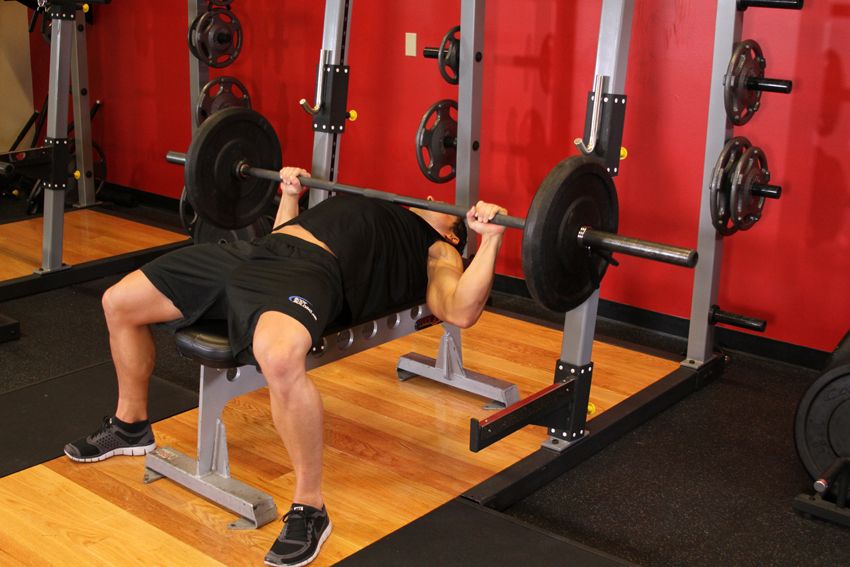Flat Barbell Bench Press
This bench press workout routine is by far the most common bench exercise.
It primarily works out the pectoralis major (chest muscles), but also works out the anterior deltoids (shoulder muscles) and triceps brachii (back of the arms). The Flat Barbell Bench Press is performed by lying on a level bench with the feet placed flat on the floor.
- Grip the bar at the point where there are smooth rings.
- Take the barbell off the rack and grip it at arm’s-length. Lower it gently to the breastbone line, and then press up in a slight backward arch so that the barbell ends up approximately over your head.
- Remember to inhale as you lower the barbell and exhale when pressing it up.
Recommended for You: How to Increase Your Bench Press
Incline Barbell Bench Press
This exercise is done using the same steps as the flat bench version, except this time the bench is inclined i.e. the upper body is raised.
The Incline Barbell Bench Press puts emphasis on the same muscle groups as the flat bench, except in this case more stress is placed on the shoulders (_trapezius)_muscles. Your upper chest or _pectoralis minor_is used more than in the flat bench.
Decline Barbell Bench Press
The procedure is similar to the flat bench press except the bench is positioned such that the upper body is will be at a lower than the lower body. Lock your legs at the end of a decline bench before slowly lying down on the bench.
Although it is a great movement, be cautious when doing declines, and make sure you have a spotter when you do it.
Flat Dumbbell Bench Press
The Flat Dumbbell bench press workout routine works out the chest muscles, and is performed as follows”
- Grab the two dumbbells using an overhand grip. Then sit down on a bench with the dumbbells supported on the lower part of the thighs.
- Lie back on the bench, with the knees bent at right angles and the feet securely on the floor. The shoulder and elbows should be at a ninety degree angle.
- Arc the back gently, tighten the abdominals, and make sure that the buttocks touch the bench throughout the lift.
- Inhale, hold your breath, and then forcefully exhale as you thrust the dumbbells in a straight line upwards as you extend your elbows.
- Squeeze your pectoral muscles. Breathe as you gently lower the dumbbells back to the starting position, and then repeat.
Incline Dumbbell Bench Press
This is performed on an incline bench. The incline version puts emphasis on the anterior deltoids and the upper pectorals.
Decline Dumbbell Fyle
In this routine, a decline bench is used. While lying down, position the dumbbells in front at shoulder width, with the arm perpendicular to the floor and fully extended. Bend your elbows slightly as you bring them lower on both sides, in a wide arch. Do this gently until tension is felt on your chest. Inhale as you perform this part of the routine. Return to the starting position and repeat.
Seated Calf Raise
The seated calf raise exercise is meant to build the calf muscles. It is performed as follows.
Sit on a bench machine and position the toes on the lower part of the platform. Then place your hands on top of the lever pad. This is to stop it from slipping forward. Gently lift the lever by pushing the heels up, and release the safety bar. Consider this the starting position.
Slowly lower the heels by bending your foot at the ankles, making sure the calves are fully stretched. Lift the heels by extending the ankles as high as possible, keeping the calves contracted. Keep the top of the calves contracted for a moment and repeat the process.
This video from Livestrong.com shows you how to properly do the seated calf raise. [youtube https://www.youtube.com/watch?v=JbyjNymZOt0?rel=0\]
Lying Triceps Kickback
This workout is primarily meant for the triceps. The routine is performed by grabbing a barbell with a narrow grip. Lie down on the bench with the barbell against your pectorals.
Make sure the back of your head is positioned over the edge of the bench. Push the bar up and position it above your eyes.
Flex the elbows to lower the bar down and back. Then move the upper arms back just enough to allow the barbell to safely move over your head. Then lower it until it is just under your head and then moves the upper arms forward as far as is needed to safely bring the bar past your head.
Slowly manoeuvre your elbows to push the bar up and forward. Return your arms back to the starting position, and then repeat.



